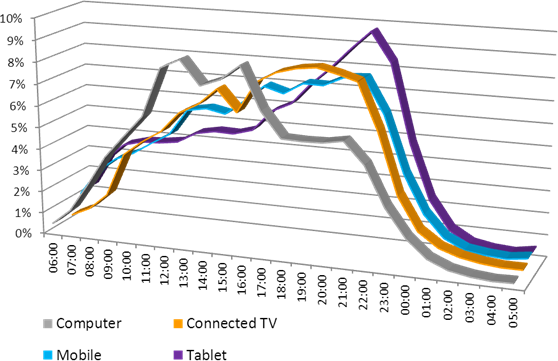Interview: Adobe Director of Video Project Management Bill Roberts
Jan Ozer sits down with Bill Roberts to discuss the trends impacting the future direction of Adobe Creative Suite for video pros, including the decline of 3D, the rise of 4K, and second-screen viewing. Other topics included the growth of Creative Cloud, and the development arc of Apple Final Cut Pro X.
Recently, I chatted with Bill Roberts, Adobe's Director of Video Project Management, about the trends impacting the future direction of the Creative Suite for video professionals, which should see another significant release around mid-2013, based on Adobe's 12–18-month release cycle. As you might suspect, the conversation veered into topics like the success of the Creative Cloud, and Apple Final Cut Pro X.

Adobe Director of Video Project Managament Bill Roberts
3D vs. 4K
SMP: What trends do you see driving the next few releases of the Creative Suite?
Roberts: One that's front-of-mind is the adoption of high-frame rate 4K formats for acquisition. Adobe just finished exhibiting at Inter BEE in Japan, which is similar to NAB here in the States. There we showed 4K workflows with JVC and Sony.
It's pretty clear that the 3D craze for the home is dying down. Panasonic recently announced that they were dropping their 3D TV sets, while Sony announced that they were rolling out 4K sets. Japan is primed for a move to 4K as they adopted HD early back when it was driven by tape-based formats. When these producers move to 4K, they'll need a file-based workflow, which we first added to CS6 via Adobe Prelude. Lots of producers who came by our booth at Inter BEE were very excited about Prelude and our 4K support.
SMP: How will this drive CS6 development?
Roberts: Fortunately, because we designed all of our products to optimize editing in native formats regardless of frame size or frame rate, it's simple to add support for most new 4K formats as vendors release them. We just tell our users they need faster hard drives.
The Second-Screen Experience
SMP: What other big trends do you see impacting the Creative Suite going forward?
Roberts: We thought it was interesting how the Olympics really created a focus on the second-screen experience. The BBC, which is one of our strategic customers, and treated the 2012 Games as inflection point to make a technology statement and create a strong second-screen experience.
They tracked viewership through the day, and found that the primary consumption platform was the computer during the day, with mobile during commute and evenings with tablet viewing along side the big-screen TV in the living room. Viewers wanted to be in the moment in the live event on the big screen and use the second screen to catch up.

Data from BBC blog post on Olympic viewing.
They also liked the greater selection offered online, which incorporated up to 24 different streams, and features like chapter marking, which allows viewers to revisit content like Usain Bolt's 100m win, which was clicked 13,000 times.
The BBC's overall numbers were staggering—they reported 55 million global browsers and 12 million devices requesting and 106 million video requests across the platform. If all the video that was watched was viewed consecutively, it would take over 7,000 years to complete. NBC has honed their second screen-experience dramatically over the years, particularly with Sunday Night Football, which is designed to augment--not replace--the TV viewing experience.
Adobe has been pounding the multiscreen drum for a while now; as you know, we added many mobile-oriented presets to CS6, plus parallel H.264 encoding when rendering a single source file to multiple renditions. So what we saw around the Olympics both in the UK and US was a nice validation. So look for more presets and encoding efficiencies in future versions.
Related Articles
Two types of noises degrade the audio you shoot with your video: random noises like microphone clicks and pops, and consistent noises like white noise or air conditioning hum. This tutorial demonstrates how to remove both of them in Adobe Audition CS6.
The 48 Hour Film Project offers filmmakers a chance at fame and glory and unleashed creativity, along with the insanity of producing a film from pre to post in two days. Scott Strimple, editor of award-winning 48HFP entries two years running, recounts what it was like putting together this year's film. In Part 2 he'll discuss the instrumental role Apple Final Cut Pro X played in editing and delivering the film with a cool 9 minutes to spare.
A new feature in Adobe Photoshop CS6 allows editing and rendering for streaming, and includes keyframeable effects and clip-layering.
Sitting down with contributing Jan Ozer on the red carpet at Streaming Media West to review the highlights and key takeaways of the show, including live streaming using the cloud, the exploding market for live stream applications, the Logitech Broadcaster Wi-Fi Webcam, Livestream's Studio HD500, and the ongoing reality/perception divide on Flash and HTML5.
In this tutorial you'll learn how to maximize the brightness and contrast of your video in Adobe Premiere Pro CS6 using the Brightness, Contrast, and Gamma Correction controls for effective and balanced adjustments.
The histogram and the waveform in Apple Final Cut Pro X are effective, easy-to-master tools that provide the clear input you need to diagnose and fix the contrast issues in your video simply and intelligently. In this video tutorial, video editing and encoding expert Jan Ozer explains how they work.
Video encoding and editing expert Jan Ozer provides three useful tips that will enhance your workflow and get you out of some editing jams in your Adobe Premiere Pro projects: editing audio without unlinking; Fill Left and Fill Right to create stereo audio; and creating nested sequences for smoother edits and creating reusable set pieces in your projects.
Adobe Premiere Pro Instructor extraordinaire Luisa Winters explains how to use the new and enhanced Multi-Camera Monitor for quick and efficient multicam edits in Adobe Premiere Pro CS6 in this video and text tutorial.
There have been lots of comparisons between Final Cut Pro X and Premiere Pro CS6, with most focusing on features and workflows. This article discusses a series of multiple-format benchmark tests that analyzed comparative performance between the two programs.
The new version of Adobe Media Encoder, included in the just-released CS6 collection as well as as a standalone product, offers significant improvements in usability and performance, as well as new features. Here's what you need to know about it.
In the final installment of the NAB Interviews with Shawn Lam, Shawn talks with Adobe's Al Mooney about key new features in Premiere Pro CS6 and Adobe Media Encoder.
When Apple originally released Final Cut Pro 10, the biggest deficit for Pro users was the lack of multicam. With the 10.0.3 release, Apple has addressed this with a highly functional and easy-to-use multicam feature, which Jan Ozer explains in this tutorial.